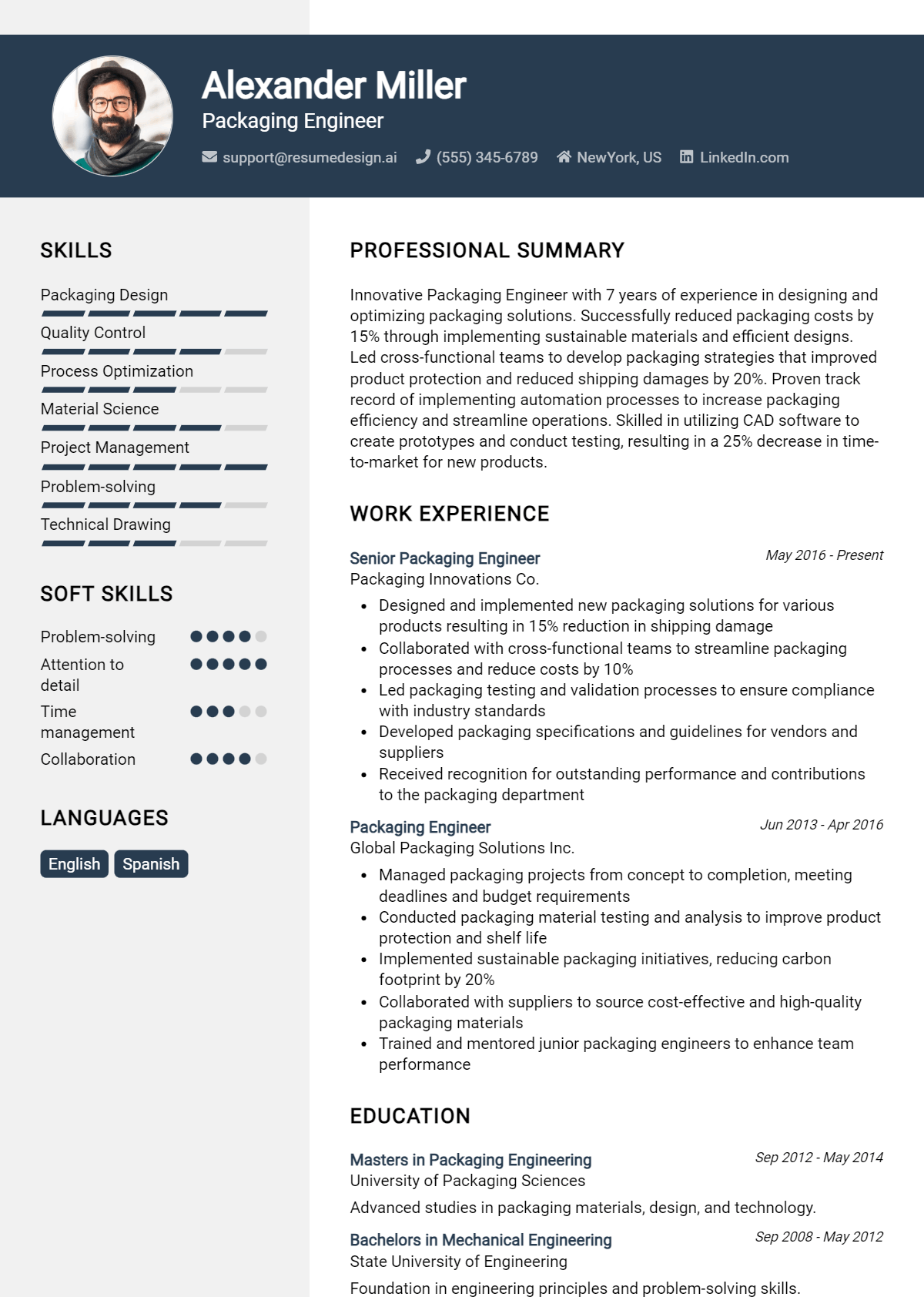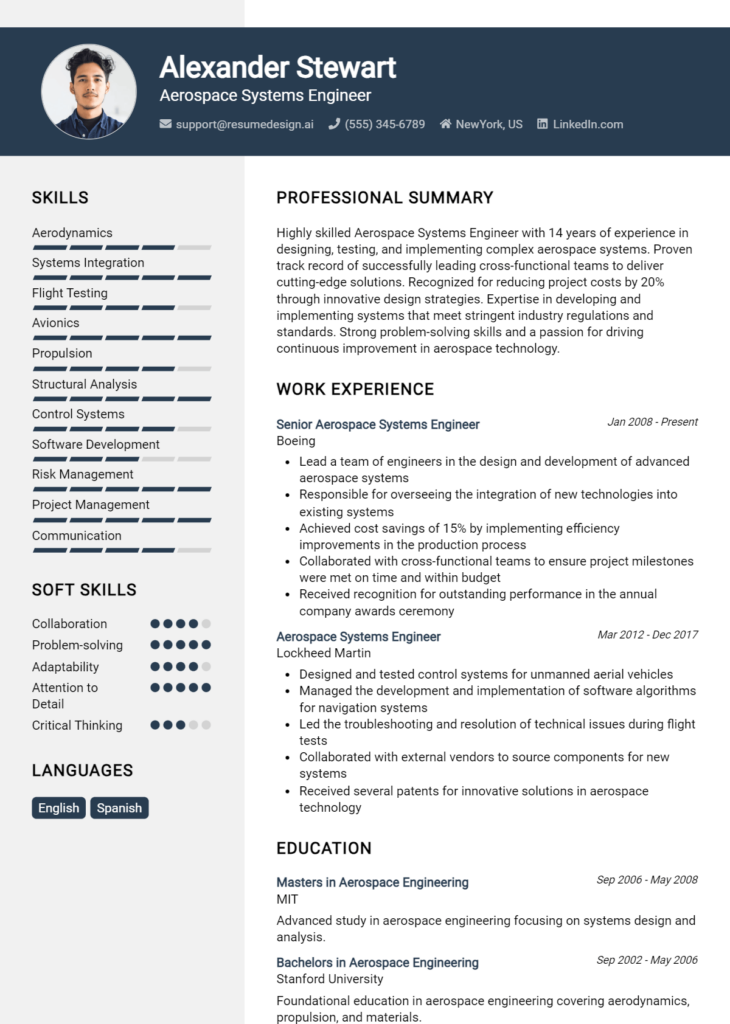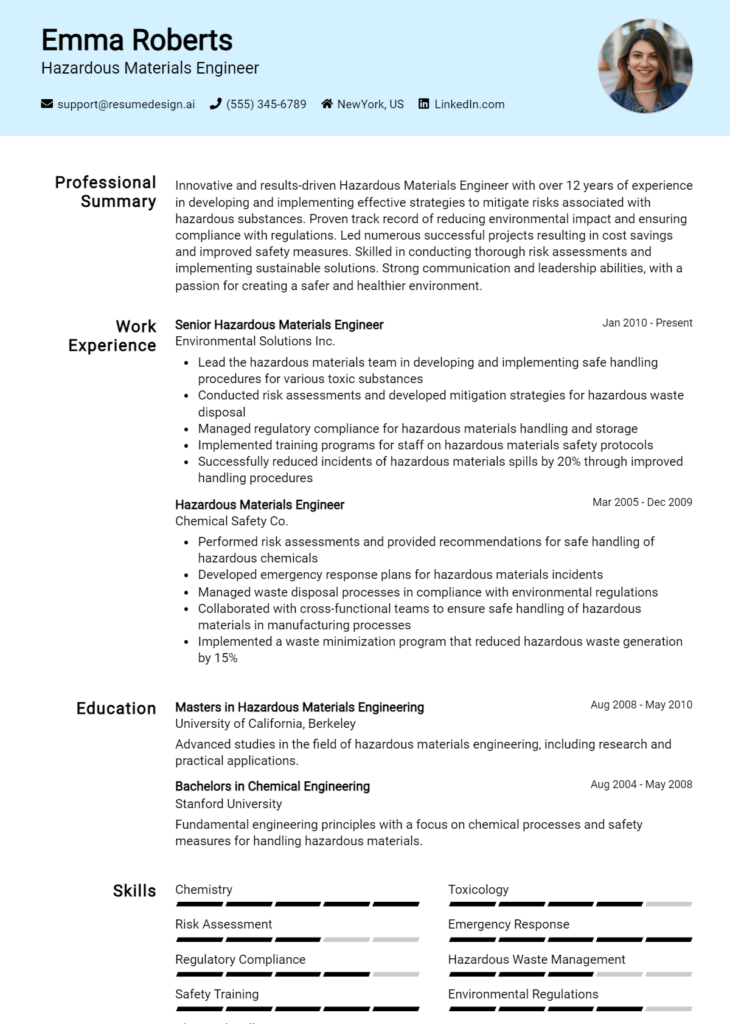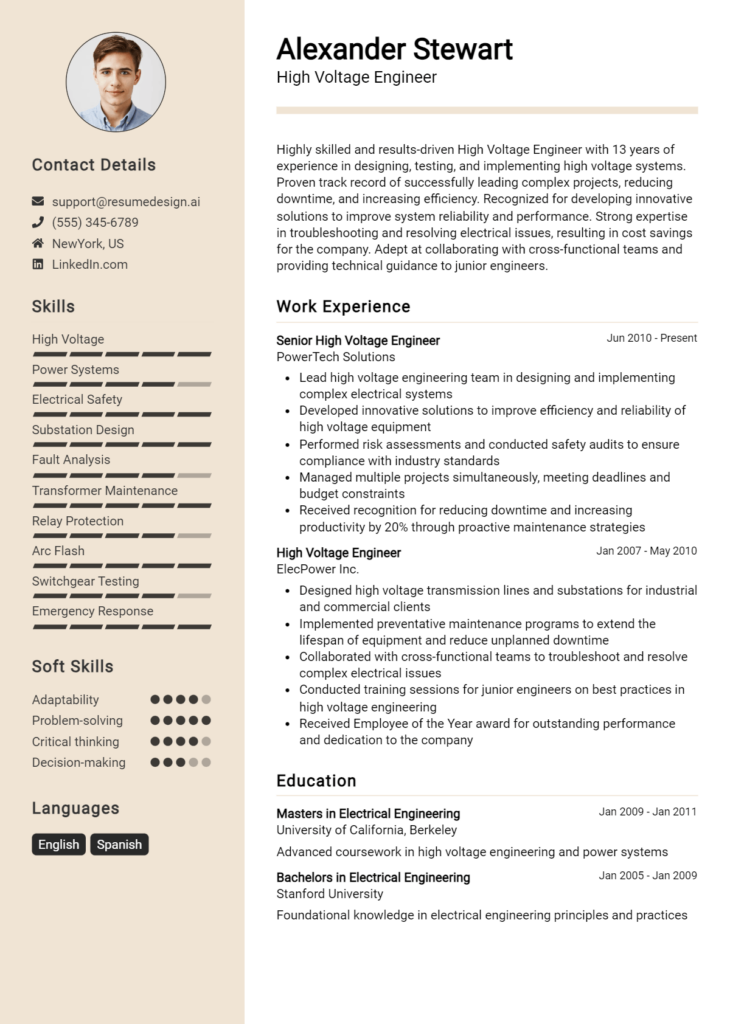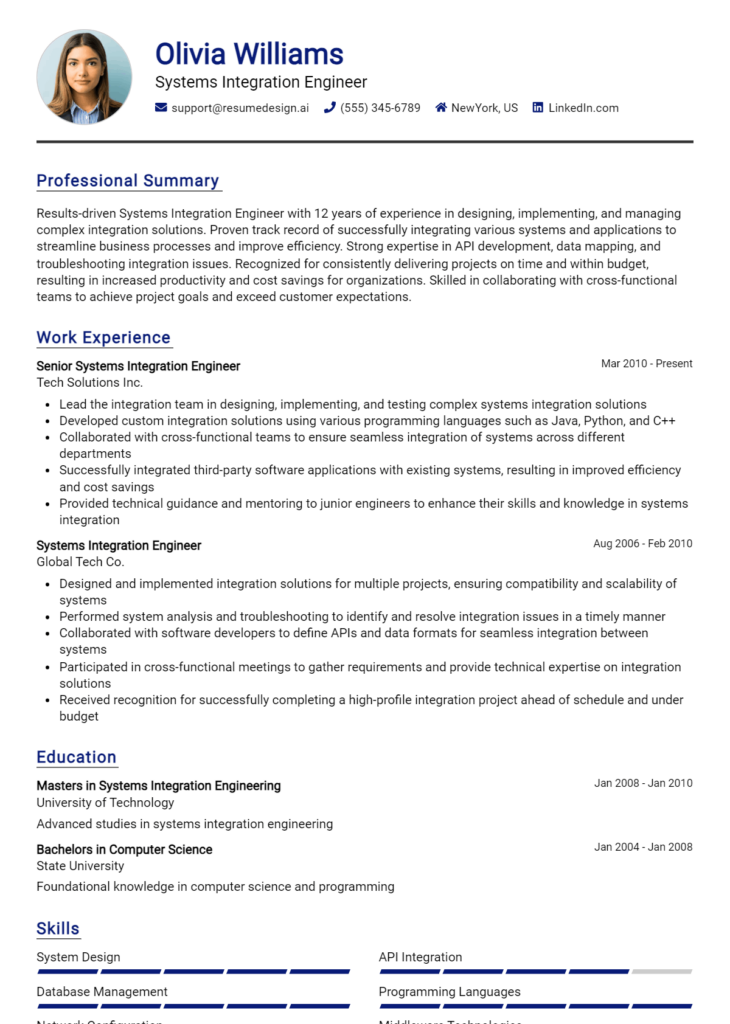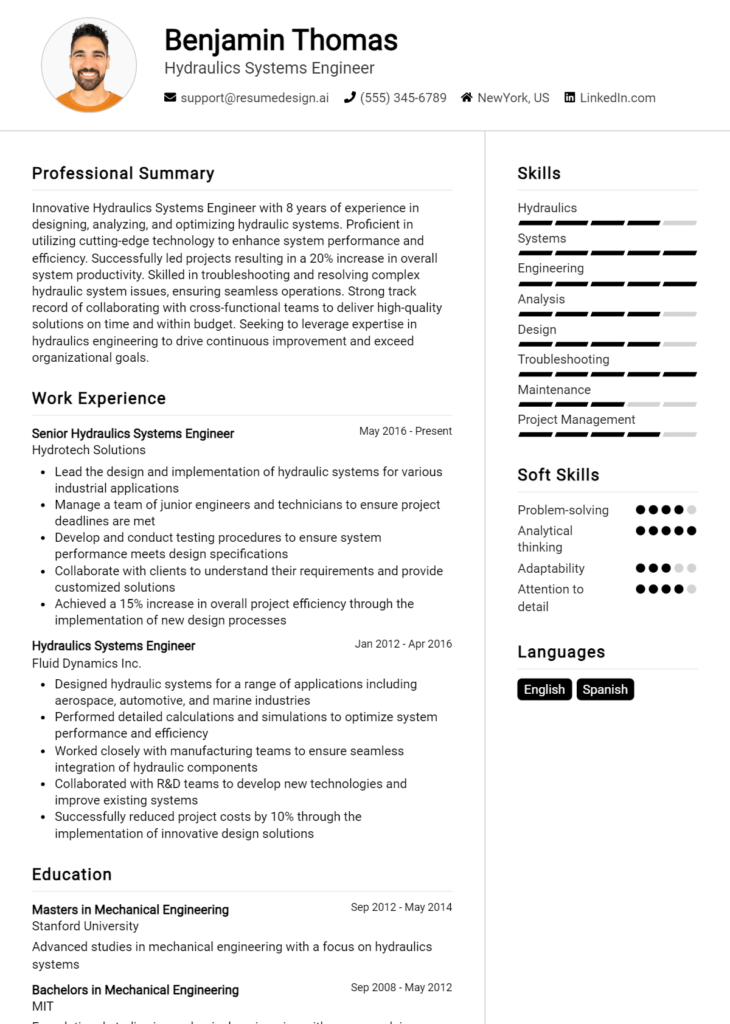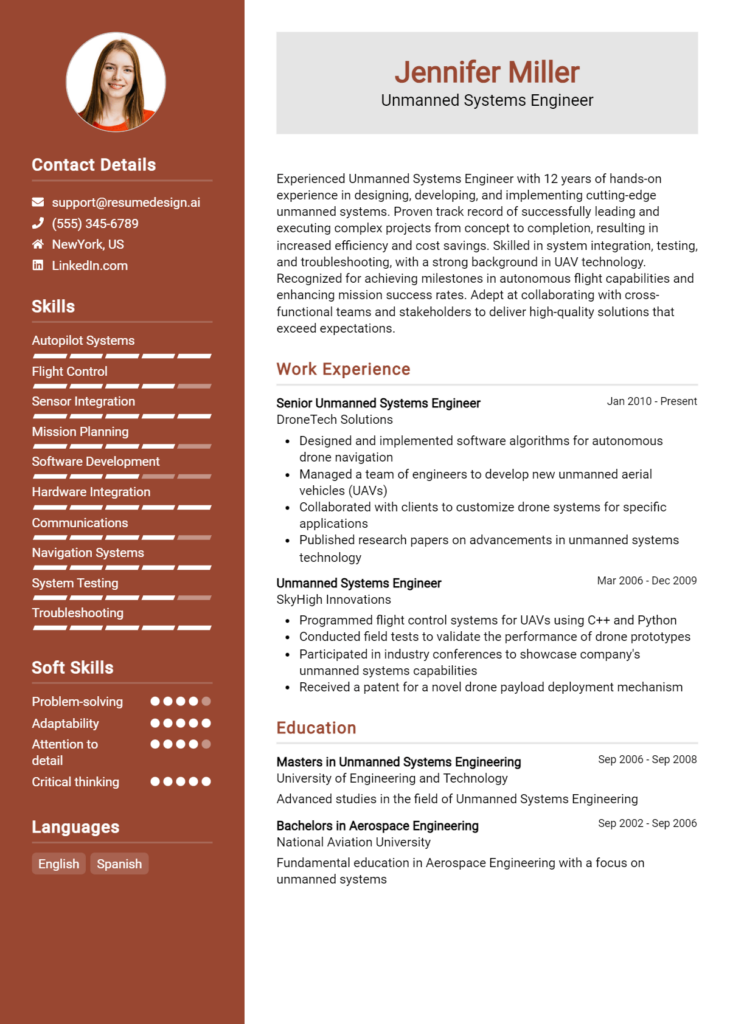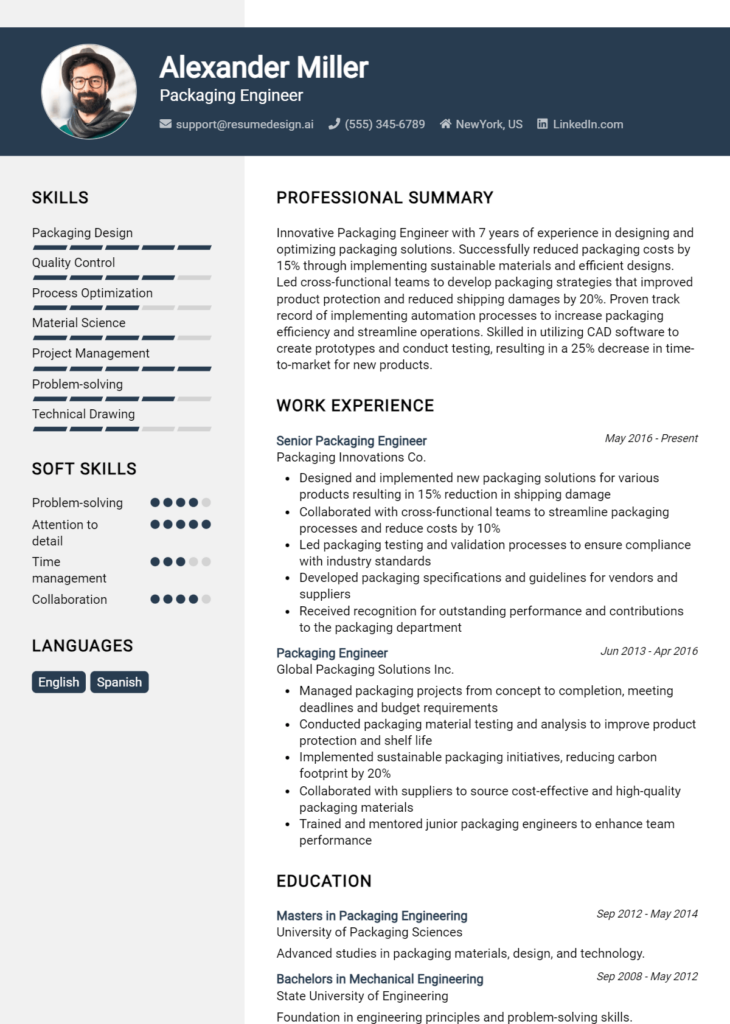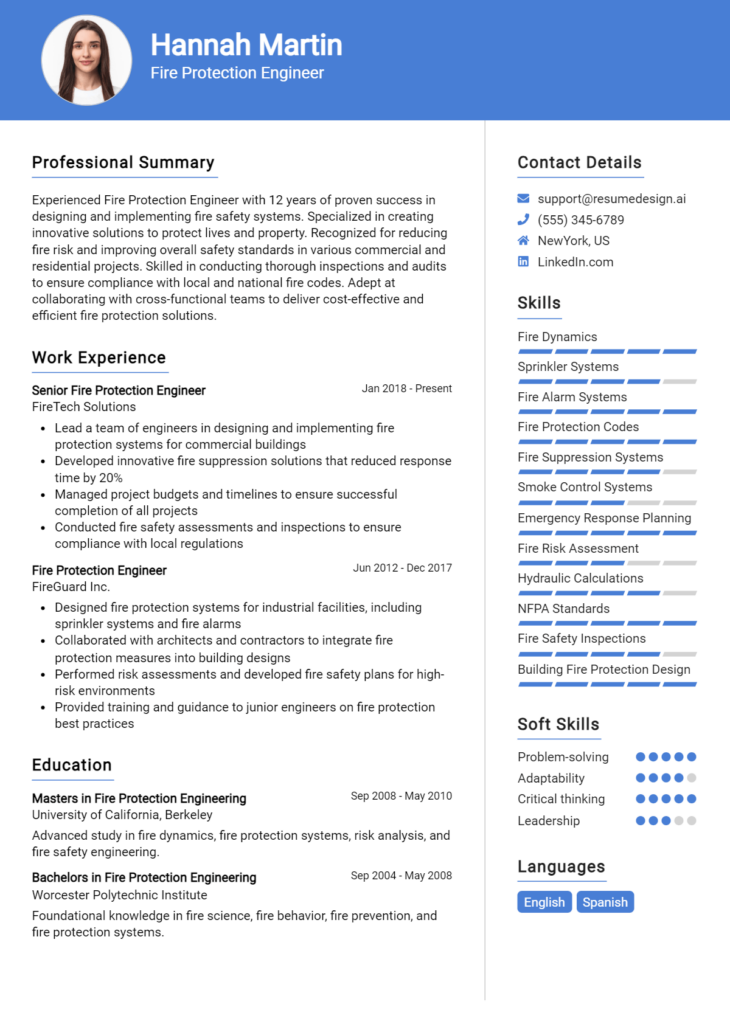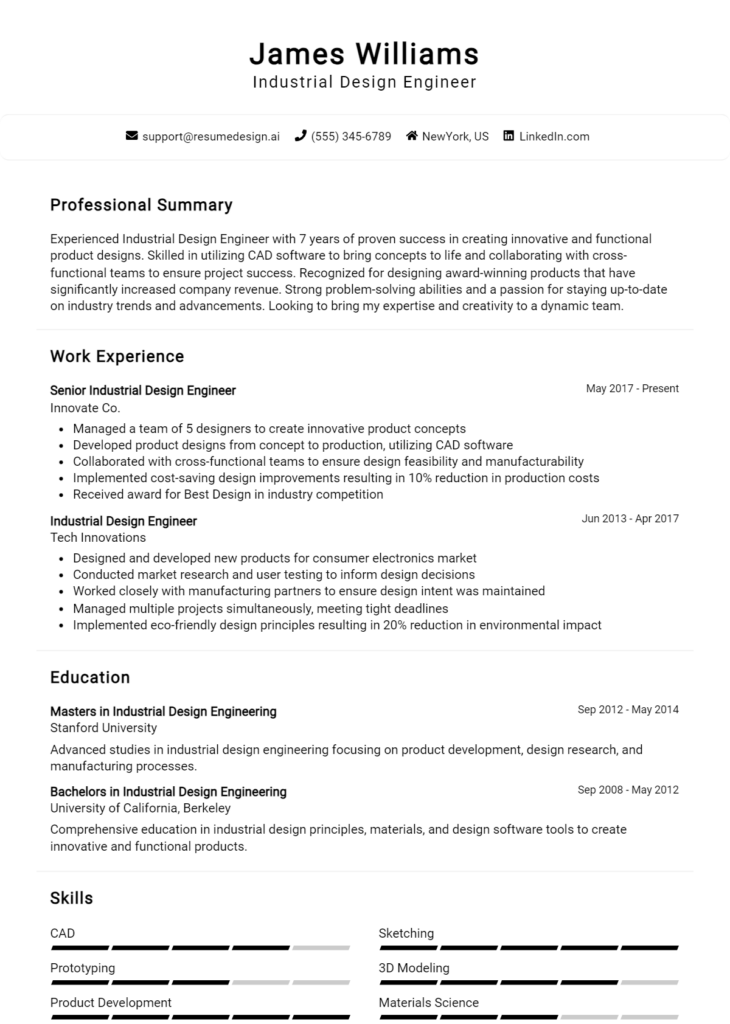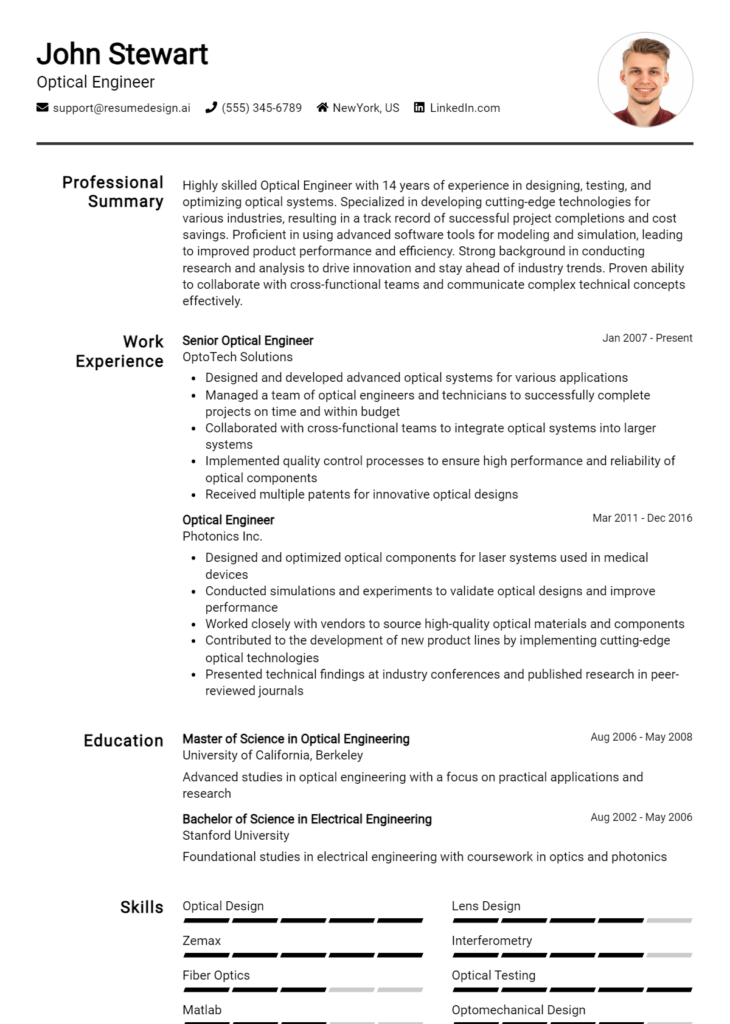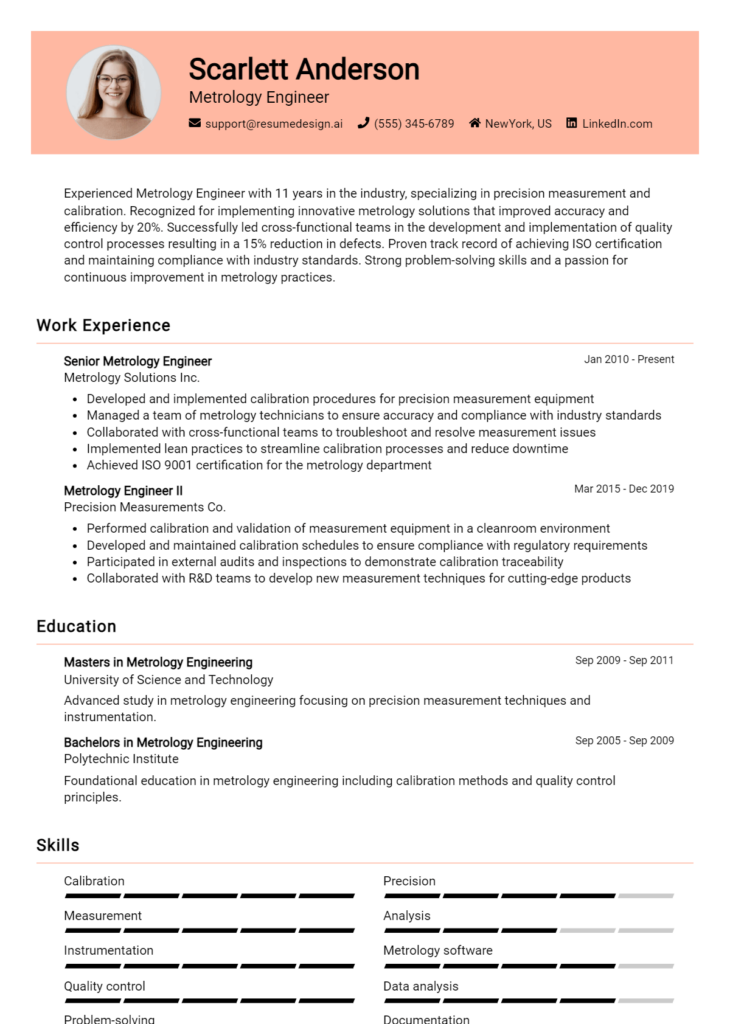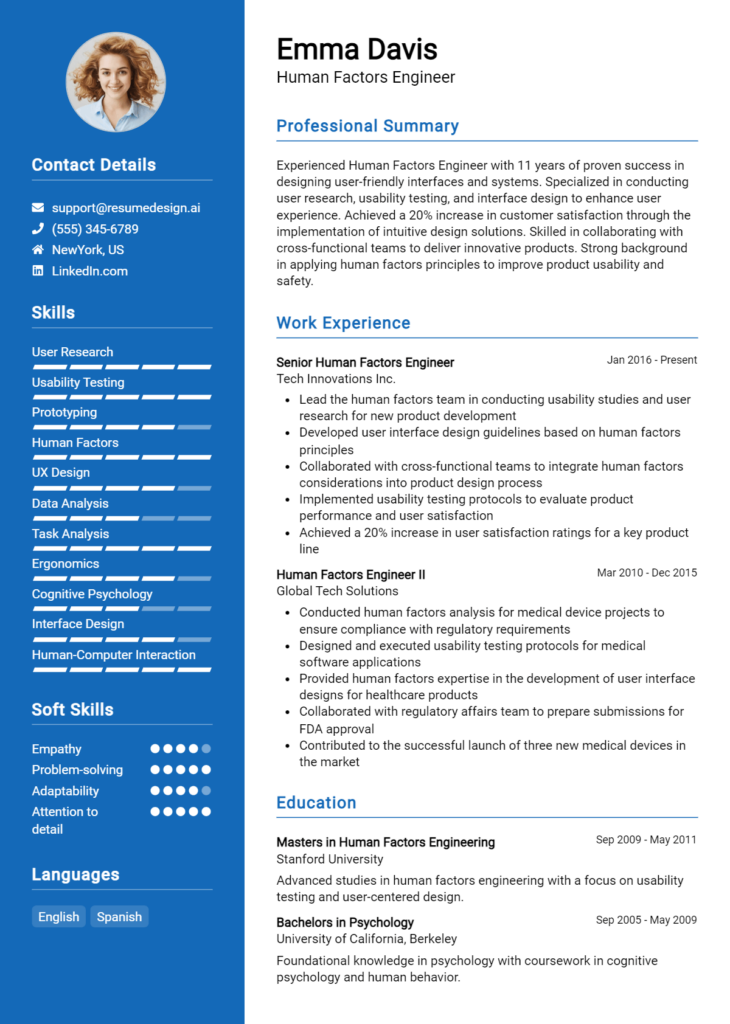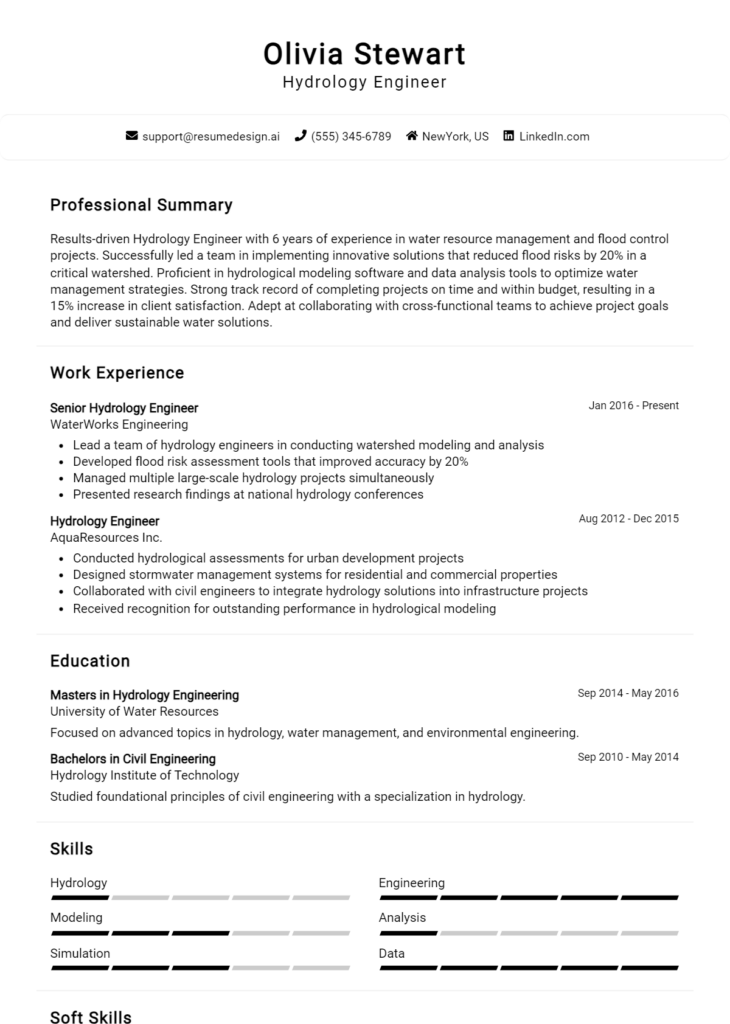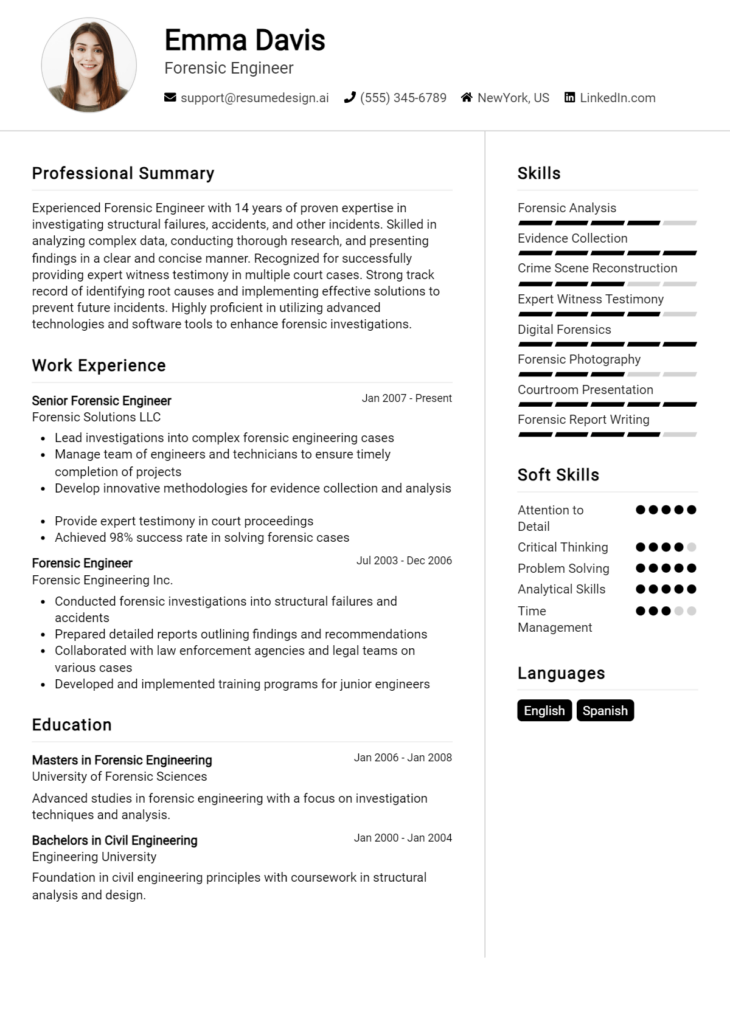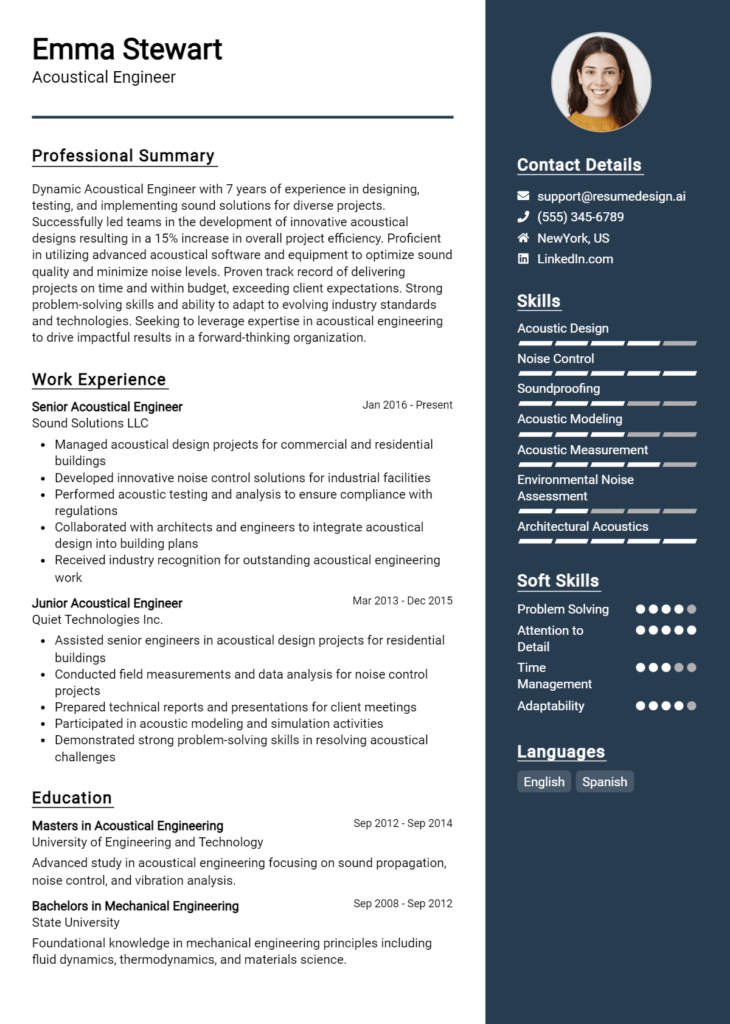Textile Engineer Core Responsibilities
A Textile Engineer plays a pivotal role in the textile industry, ensuring the seamless integration of design, production, and quality control. Key responsibilities include developing new fabrics, optimizing manufacturing processes, and conducting research to improve textile performance. Strong technical, operational, and problem-solving skills are essential for troubleshooting issues and enhancing product quality. These abilities not only contribute to organizational goals but also foster collaboration across departments. A well-structured resume can effectively highlight these qualifications, showcasing a candidate's expertise and enhancing employability.
Common Responsibilities Listed on Textile Engineer Resume
- Designing and developing new textile products and processes.
- Conducting research on fiber properties and fabric performance.
- Overseeing the production process to ensure quality standards.
- Collaborating with designers, manufacturers, and quality teams.
- Implementing cost-reduction strategies in material and production.
- Testing and analyzing textiles for durability and functionality.
- Advising on sustainability practices in textile production.
- Managing project timelines and resource allocation.
- Providing technical support to production staff.
- Maintaining compliance with industry regulations and standards.
- Developing and documenting technical specifications and reports.
High-Level Resume Tips for Textile Engineer Professionals
In the competitive field of textile engineering, a well-crafted resume serves as your first opportunity to make a lasting impression on potential employers. It is crucial for your resume to reflect not only your technical skills and industry knowledge but also your achievements and contributions to past projects. A strong resume can effectively communicate your qualifications and set you apart from other candidates. This guide will provide practical and actionable resume tips specifically tailored for Textile Engineer professionals, helping you craft a document that showcases your unique qualifications and makes a compelling case for your candidacy.
Top Resume Tips for Textile Engineer Professionals
- Tailor your resume to match the job description, emphasizing the skills and experiences that align with the specific requirements of the position.
- Highlight relevant experience by focusing on projects that demonstrate your expertise in textile design, production processes, or material science.
- Quantify your achievements where possible, using metrics to illustrate the impact of your work, such as percentage increases in efficiency or cost savings.
- Incorporate industry-specific keywords that are commonly found in job descriptions to pass through Applicant Tracking Systems (ATS).
- Showcase technical skills related to textile engineering, such as proficiency in CAD software, knowledge of fiber properties, and familiarity with manufacturing processes.
- Include certifications or training relevant to textile engineering, such as Six Sigma or Lean Manufacturing, to enhance your qualifications.
- Use clear and concise language to make your resume easy to read, avoiding jargon unless it is industry-standard terminology.
- Keep your resume well-organized and visually appealing, using headings and bullet points to guide the reader’s eye to the most important information.
- Consider adding a summary statement at the beginning of your resume that encapsulates your career goals and key qualifications in textile engineering.
By implementing these tips, you can significantly enhance your resume's effectiveness, increasing your chances of landing a job in the textile engineering field. A strong resume not only highlights your skills and experience but also demonstrates your commitment to the profession, making you a more attractive candidate to potential employers.
Why Resume Headlines & Titles are Important for Textile Engineer
Resume headlines and titles play a crucial role in a Textile Engineer's job application, serving as the first impression a hiring manager will have of a candidate. A strong headline or title can immediately grab attention, encapsulating a candidate's key qualifications in a single impactful phrase. It should be concise, relevant, and directly related to the job being applied for, allowing candidates to stand out in a competitive job market and effectively communicate their expertise in textile engineering.
Best Practices for Crafting Resume Headlines for Textile Engineer
- Keep it concise: Aim for a headline that is no more than 10-15 words.
- Be role-specific: Tailor the headline to reflect the specific position you are applying for.
- Highlight key skills: Include essential skills or areas of expertise relevant to textile engineering.
- Showcase accomplishments: If applicable, mention notable achievements to add weight to your headline.
- Use industry keywords: Incorporate relevant terminology that aligns with the job description.
- Aim for impact: Choose powerful words that convey confidence and professionalism.
- Consider your audience: Tailor the tone and language based on the company’s culture and values.
- Update regularly: Revise your headline for each application to ensure it remains relevant.
Example Resume Headlines for Textile Engineer
Strong Resume Headlines
Innovative Textile Engineer Specializing in Sustainable Fabric Development
Experienced Textile Engineer with a Proven Track Record in Quality Control
Dynamic Textile Engineer with Expertise in Advanced Manufacturing Techniques
Weak Resume Headlines
Textile Engineer Looking for a Job
Experienced Professional in Textiles
Strong headlines are effective because they immediately convey the candidate's expertise and focus, making a memorable impact on hiring managers. They utilize specific language and highlight relevant skills, which can set a candidate apart from others. In contrast, weak headlines fail to impress because they lack specificity and do not provide any insight into the candidate's qualifications or unique contributions, ultimately blending into a sea of generic applications.
Writing an Exceptional Textile Engineer Resume Summary
A well-crafted resume summary is crucial for a Textile Engineer, as it serves as the first impression for hiring managers. This concise overview quickly highlights key skills, relevant experience, and notable accomplishments, helping candidates stand out in a competitive job market. A strong summary not only captures attention but also aligns with the specific requirements of the job, making it essential for candidates to tailor their summaries accordingly. By doing so, they can effectively communicate their value and suitability for the role, increasing their chances of landing an interview.
Best Practices for Writing a Textile Engineer Resume Summary
- Quantify achievements when possible to provide tangible evidence of your impact.
- Focus on key skills that are directly aligned with the job description.
- Use industry-specific terminology to demonstrate your knowledge and expertise.
- Keep the summary concise, ideally within 3-5 sentences, to maintain clarity.
- Highlight your unique selling points, such as certifications or specialized training.
- Tailor each summary to the specific job you are applying for to show relevance.
- Incorporate action verbs to convey proactivity and engagement in your work.
- Ensure proper grammar and spelling to maintain professionalism in presentation.
Example Textile Engineer Resume Summaries
Strong Resume Summaries
Detail-oriented Textile Engineer with over 5 years of experience in fabric development, resulting in a 30% reduction in production costs through innovative material sourcing. Proficient in CAD software and skilled in implementing sustainable practices in textile manufacturing.
Results-driven Textile Engineer with a proven track record of increasing production efficiency by 25% through process optimization. Experienced in leading cross-functional teams and managing large-scale projects, with expertise in dyeing and finishing techniques.
Dynamic Textile Engineer specializing in smart textiles, with a successful history of developing wearable technology that enhances functionality and user experience. Increased product marketability by 15% through targeted research and innovative design.
Weak Resume Summaries
Experienced textile professional looking for new opportunities in the industry.
Textile Engineer with a background in various roles, seeking a position to utilize my skills.
The examples of strong resume summaries stand out due to their specific achievements, quantifiable outcomes, and relevant skills that align closely with the Textile Engineer role. They provide a clear narrative of the candidate's impact and expertise. In contrast, the weak resume summaries lack specificity and measurable results, making them generic and less engaging. They fail to highlight the candidate's true potential or how they can contribute to the prospective employer's needs.
Work Experience Section for Textile Engineer Resume
The work experience section of a Textile Engineer resume plays a vital role in demonstrating a candidate's qualifications and suitability for the role. It showcases essential technical skills, a capacity for team management, and the ability to deliver high-quality products within specified timelines. This section not only reflects the candidate's hands-on experience but also highlights their achievements in a quantifiable manner, ensuring alignment with industry standards. By articulating results and responsibilities clearly, job seekers can effectively communicate their value to potential employers.
Best Practices for Textile Engineer Work Experience
- Focus on technical skills relevant to textile engineering, such as fabric production, quality control, and textile machinery operation.
- Quantify achievements with metrics, such as percentage improvements, cost savings, or production increases.
- Highlight leadership roles in projects, showcasing your ability to manage teams and drive results.
- Use action verbs to describe your contributions, emphasizing your proactive approach to problem-solving.
- Align your work history with industry standards and emerging technologies in textile engineering.
- Include collaborative projects that demonstrate your ability to work effectively with cross-functional teams.
- Tailor your experience to the specific job description, emphasizing the most relevant roles and accomplishments.
- Keep descriptions concise and focused, avoiding jargon that may not be familiar to all readers.
Example Work Experiences for Textile Engineer
Strong Experiences
- Led a team of 10 engineers in the development of a new sustainable fabric line, resulting in a 30% reduction in production costs and a 50% increase in customer satisfaction ratings.
- Implemented a quality control system that decreased defects by 25%, improving overall product reliability and enhancing brand reputation.
- Collaborated with suppliers to source innovative materials that reduced environmental impact by 40%, aligning with industry sustainability goals.
- Managed a project to upgrade textile machinery, increasing production efficiency by 20% and reducing downtime by 15%.
Weak Experiences
- Worked on various textile projects without specifying results or contributions.
- Assisted in fabric production tasks, but did not clarify the extent of involvement or any achieved outcomes.
- Participated in team meetings related to textile engineering without detailing the purpose or impact of those meetings.
- Helped with quality checks but failed to mention any improvements or changes made to the process.
The examples listed as strong experiences are effective because they provide specific, quantifiable results that highlight leadership and collaboration in textile engineering projects. They demonstrate clear contributions to the organization’s success, showcasing both technical expertise and the ability to drive improvements. In contrast, the weak experiences lack detail and measurable outcomes, making it difficult for potential employers to assess the candidate’s true impact and capabilities in the field.
Education and Certifications Section for Textile Engineer Resume
The education and certifications section of a Textile Engineer resume plays a pivotal role in establishing the candidate's academic foundation and professional expertise in the textile industry. This section not only showcases the candidate's relevant degrees and specialized training but also emphasizes their commitment to continuous learning and professional development. By including industry-relevant coursework and certifications, candidates can significantly enhance their credibility, demonstrating their alignment with the specific demands and technological advancements of the textile engineering field. This comprehensive overview of educational qualifications allows hiring managers to assess the applicant's preparedness for the challenges of the role.
Best Practices for Textile Engineer Education and Certifications
- Prioritize relevance: Include degrees and certifications that directly relate to textile engineering.
- Detail your coursework: Highlight specific courses that showcase your knowledge in key areas such as fabric technology, textile manufacturing, and quality control.
- List advanced degrees: If applicable, include master's degrees or PhDs that demonstrate advanced knowledge and expertise.
- Highlight industry-recognized certifications: Mention certifications from reputable organizations that validate your skills and knowledge.
- Include specialized training: Add any workshops, seminars, or training sessions that focus on current textile technologies or methodologies.
- Be concise but informative: Provide enough detail to convey significance without overwhelming the reader with excessive information.
- Keep it updated: Regularly review and amend this section to reflect the latest qualifications and skills acquired.
- Use formatting for clarity: Organize the information in a clear and visually appealing manner to enhance readability.
Example Education and Certifications for Textile Engineer
Strong Examples
- Bachelor of Science in Textile Engineering, University of California, Davis, 2020
- Certified Textile Technician (CTT), Textile Institute, 2021
- Advanced Fabric Analysis Course, American Association of Textile Chemists and Colorists, 2022
- Master’s Degree in Textile and Apparel Management, North Carolina State University, 2023
Weak Examples
- Bachelor of Arts in English Literature, Some University, 2018
- Certification in Basic Sewing Techniques, 2019 (not industry relevant)
- High School Diploma, Some High School, 2015
- Outdated Certification in Textile Quality Control, 2015
The strong examples are considered relevant and impactful as they directly align with the skills and knowledge required for a Textile Engineer role. They showcase advanced education and industry-recognized certifications that reflect the candidate’s commitment to the field. In contrast, the weak examples lack relevance and do not contribute to the candidate's qualifications for a career in textile engineering. They either pertain to unrelated fields or are outdated, thus failing to demonstrate the candidate's capability in a rapidly evolving industry.
Top Skills & Keywords for Textile Engineer Resume
In the competitive world of textile engineering, a well-crafted resume that highlights key skills can significantly enhance your chances of landing a desirable position. The textile industry demands a unique blend of technical and interpersonal capabilities, which are essential for ensuring the quality, efficiency, and innovation of textile products. Prospective employers look for candidates who not only possess relevant hard skills but also demonstrate strong soft skills that enable effective collaboration and problem-solving. By showcasing these skills effectively on your resume, you can present yourself as a well-rounded candidate ready to tackle the challenges of the industry.
Top Hard & Soft Skills for Textile Engineer
Soft Skills
- Communication Skills: Ability to convey ideas clearly and effectively to various stakeholders.
- Teamwork: Collaborating with cross-functional teams to achieve common goals.
- Problem-Solving: Analyzing issues and developing innovative solutions in textile production.
- Attention to Detail: Ensuring precision in design and manufacturing processes.
- Time Management: Prioritizing tasks to meet deadlines in fast-paced environments.
- Adaptability: Adjusting to new technologies and methods in a dynamic industry.
- Creativity: Designing aesthetically appealing and functional textile products.
- Leadership: Guiding teams and projects toward successful outcomes.
- Negotiation Skills: Effectively managing supplier and client relationships.
- Critical Thinking: Evaluating processes and making informed decisions to improve efficiency.
Hard Skills
- Textile Design: Proficiency in designing fabrics and patterns using software tools.
- Fabric Production: Knowledge of weaving, knitting, and finishing processes.
- Quality Control: Implementing testing methods to ensure product standards.
- Material Science: Understanding the properties and applications of different fibers and materials.
- CAD Software: Experience with computer-aided design tools for textile engineering.
- Sustainability Practices: Knowledge of eco-friendly materials and production methods.
- Textile Testing: Familiarity with laboratory procedures for evaluating fabric performance.
- Process Optimization: Skills in improving manufacturing processes for efficiency.
- Project Management: Ability to oversee projects from conception to completion.
- Regulatory Compliance: Understanding industry standards and regulations affecting textile production.
By integrating these skills into your resume, along with a detailed account of your work experience, you can create a compelling narrative that highlights your qualifications as a textile engineer.
Stand Out with a Winning Textile Engineer Cover Letter
Dear [Hiring Manager's Name],
I am writing to express my interest in the Textile Engineer position at [Company Name], as advertised on [Job Portal/Company Website]. With a degree in Textile Engineering and over [X years] of hands-on experience in textile manufacturing and product development, I am excited about the opportunity to contribute to your team. My background in fabric technology, coupled with my proficiency in sustainable textile solutions, aligns perfectly with your company's commitment to innovation and quality.
Throughout my career, I have successfully managed various projects that involved developing new textile products and improving existing processes. At [Previous Company Name], I led a team that implemented a new dyeing technique, which not only reduced water consumption by 30% but also enhanced the colorfastness of our fabrics. My ability to analyze and optimize production processes has consistently resulted in improved efficiency and cost savings, which I believe will be beneficial to [Company Name] as it continues to expand its product offerings.
I am particularly drawn to this position because of [Company Name]'s emphasis on sustainability and cutting-edge technology in textile production. As someone who is passionate about eco-friendly practices, I am eager to bring my expertise in developing sustainable materials and processes to your organization. I am confident that my innovative mindset and technical skills will make a meaningful contribution to your team and help [Company Name] maintain its reputation as a leader in the textile industry.
Thank you for considering my application. I look forward to the possibility of discussing how my background, skills, and enthusiasms can be in alignment with the exciting projects at [Company Name]. I am eager to bring my experience in textile engineering to your esteemed organization and help drive its mission forward.
Sincerely,
[Your Name]
[Your Contact Information]
[LinkedIn Profile or Portfolio URL]
Common Mistakes to Avoid in a Textile Engineer Resume
Creating an effective resume as a Textile Engineer is crucial for standing out in a competitive job market. However, many candidates make common mistakes that can diminish their chances of securing an interview. By being aware of these pitfalls, you can craft a resume that highlights your skills and experience in the best possible light. Here are some common mistakes to avoid:
Generic Objective Statements: Using a vague or generic objective statement can make your resume blend in with others. Tailor your objective to reflect your specific goals and how they align with the company's mission.
Lack of Relevant Keywords: Failing to incorporate industry-specific keywords can result in your resume being overlooked by applicant tracking systems (ATS). Review the job description and include relevant terms that showcase your expertise.
Overloading with Technical Jargon: While it's important to demonstrate your technical knowledge, excessive jargon can confuse hiring managers. Use clear language that balances technical terms with easily understandable explanations.
Ignoring Soft Skills: Focusing solely on technical skills can make your resume one-dimensional. Highlighting soft skills such as teamwork, communication, and problem-solving is essential in demonstrating your overall fit for the role.
Inconsistent Formatting: An unorganized or inconsistent layout can distract from your qualifications. Use uniform fonts, bullet points, and headings to create a clean and professional appearance.
Neglecting Achievements: Simply listing job duties without showcasing accomplishments can make your experience seem less impactful. Quantify your achievements whenever possible to illustrate your contributions to previous employers.
Including Irrelevant Experience: Adding unrelated work experience can dilute the focus of your resume. Stick to experiences that are relevant to the textile engineering field to maintain clarity and relevance.
Failure to Proofread: Spelling and grammatical errors can create an impression of carelessness. Always proofread your resume multiple times or enlist a friend to ensure it is free from mistakes.
Conclusion
As a Textile Engineer, your expertise in fabric production, textile technology, and material properties is crucial in driving innovation and quality in the textile industry. Throughout the article, we explored the essential skills and qualifications needed for this role, including a strong foundation in engineering principles, an understanding of textile manufacturing processes, and proficiency in design software. Additionally, we discussed the importance of staying updated with industry trends and advancements to remain competitive in the job market.
Now that you have a clearer understanding of what it takes to succeed as a Textile Engineer, it’s time to reflect on your own professional profile. A well-crafted resume is your ticket to showcasing your skills and experiences effectively. We encourage you to review your Textile Engineer resume and consider how you can enhance it to attract potential employers.
To assist you in this process, we offer a range of invaluable tools. Explore our resume templates to find a design that aligns with your personal brand. Utilize our resume builder for an easy and efficient way to create a polished resume. For inspiration, check out our collection of resume examples tailored to various engineering roles. Lastly, don’t forget to craft a compelling introduction with our cover letter templates.
Take action today and ensure your resume reflects the professionalism and expertise you bring as a Textile Engineer!

